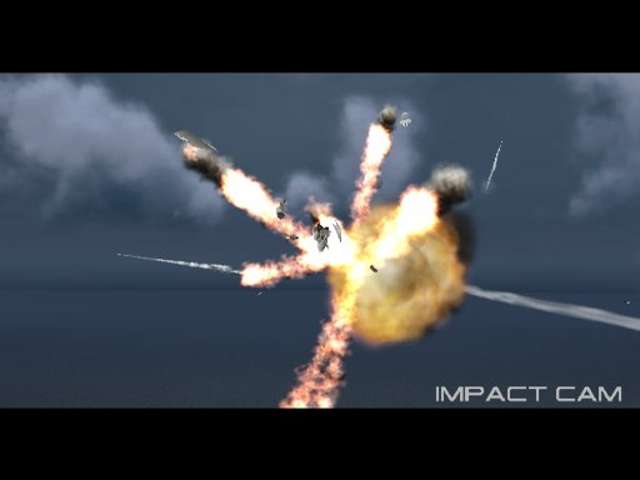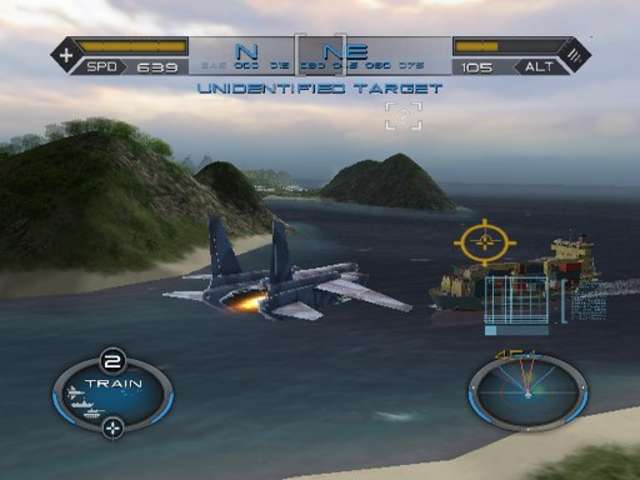Heatseeker
Less Maverick, more Goose.
Heatseeker is kind of a damning indictment of Western games development. In reviewing it you've got to draw a comparison to the Japanese arcade jet fighting Ace Combat series because, well, Heatseeker is something of an 'homage' to it, and the differences between the two are clear. Ace Combat is an enormously polished license that tries to wrap you up in a beautiful frontend and an atmosphere of desperate comms chatter, highly vulnerable planes and a story that's rich with personal belief and tough decisions. Heatseeker on the other hand is being sold on its 'Impact Cam'. The Impact Cam is a camera that follows your missiles right up to the point of impact then shows you the explosion up close and in slow motion. Imagining the project lead meetings side by side is pretty depressing. Immaculately dressed Japanese men discussing how to best convey the horror of war next to twenty-something execs in t-shirts unanimously deciding the player needs to see the explosions closer and slower.
Depending on how much you like explosions or hate stuff that isn't exploding, you might even find the Impact Cam to be a negative thing. For one you always seem to accidentally activate it when you're in the middle of some evasive manoeuvres you absolutely do not want to be dragged away from. This isn't like Max Payne's ultra-fast sniper rifle, either. Missiles take time to reach their target. So you're left, invulnerable and going in a straight line, for the entire duration of its flight.
What's most irritating is it only ever activates when your ordnance is going to hit and destroy your target, which is normally a tense and unsure thing. With the Impact Cam you just sit back and watch your shot inevitably find its mark. It also means Heatseeker in some way decides whether your shot hits before you've pulled the trigger, and it's not down to fancy AI flying or flare dropping. Annoying.

One Of Life's Simple Joys
After you strip away that key feature there really isn't much left. 18 missions are tied together by a hollow plot and the world's most awesomely generic voice acting. Regular checkpoints within levels ensure you never get too frustrated by losing progress but also mean you never really fear death. Each level has three bonus objectives that unlock new weapon loadouts, new planes or plane variants, although lots of them can only be used outside of the campaign in arcade mode. The campaign mode is really just there to act as a backdrop for the action and give the player a bit of focus. There's nothing like Ace Combat's medal collection, cutscenes or flight statistics here. But there is a half decent replication of Ace Combat's action.
Missions mostly involve being given a series of things to blow up, either static structures or enemies whose strange and mysterious tactics dictate they attack in nice, manageable waves. Obliterating lone enemies is a cakewalk but things get nice and hectic when you're in the thick of lots of them. For instance, trying to destroy a surfaced submarine while under fire from missile boats and fighter jets. And when that submarine starts firing cruise missiles that have to be taken down before they reach your airfield - well. That said, things start fairly slowly. The trickiest part of the first campaign comes when you're told to set your bird down on an aircraft carrier (which you're told you absolutely much approach from the 'rear'. Anyone know how to figure out which is the front end of a static, low-res aircraft carrier?)
Playing With The Boys

Making a mess of the bad guys' machines is down to locking onto a target. You're always equipped with a machine gun but it's fairly dire and the spray and pray usage required makes a mess of your accuracy percentage at the end of a level. What you want to do is get in range of something, get it as close to the centre of the screen as possible (the closer it is, the faster the lock) and then fire away when the targeting reticule changes colour. Variety's added to the mix by an arsenal of unguided and guided bombs, fuel air bombs, torpedoes (which require a cool, low and slow delivery into the water but are sadly weak) and rocket pods. The slower you go, the more chance you have to fire on slow moving targets and the more agile you are, but there's more chance of you getting locked yourself.
When you get locked things proceed a little differently to Ace Combat. Heavy dogfights in AC naturally involve you getting locked perpetually and never stopping your aerial acrobatics. Being locked in Heatseeker is much rarer and breaking free involves a QTE style moment where a button flashes up on the screen and hitting it in time results in a sideways roll or dropping flares. You might prefer the cinematic look of this system, or you might dislike watching the game take over and save your ass. It's personal taste. But fail at it enough times and you will hate it because the plume of smoke your plane leaks when it's taken heavy damage pours right into the third person camera, forcing you to swap to the in-cockpit view.
Unless you're really against a game that takes itself seriously there's nothing to recommend Heatseeker over Ace Combat, especially not since the last AC, Belkan War, made a serious effort to recreate the kind of one-on-one duels we've all seen in the movies and expect from dogfighting. Heatseeker feels like a step back, a simpler, uglier, dumber but friendlier jetfighter that plants you firmly in the role of the one man army. To put it another way, Ace Combat expects you to be upset at the scripted, drawn-out death of your wingman and Heatseeker lets you fly into the ground and bounce off with a bit of damage. The only thing Heatseeker succeeds at is being a close approximation of a superior game. If you don't mind supporting that and you like your gaming ultra-casual, you're clear for take-off.

